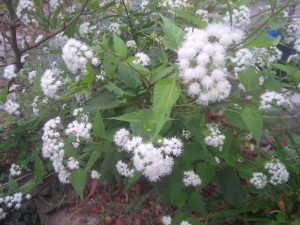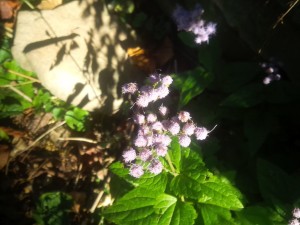
Late fall is dominated by orange, red, russet and gold, as brilliant leaves, goldenrod and millions of cushion mums crash together in a colorful, season-ending plant eruption. But the prelude to all that brilliance rolls through in early fall, in the form of blue, pink, purple and white asters, boltonia and fall-blooming crocuses. A less known traveling companion is blue boneset, aka wild ageratum, perennial ageratum, mistflower and blue mistflower. Its botanist friends used to call it Eupatorium coelestinum. Now they have found a name that twists the tongue even more—Conoclinium coelestinum. Latin names may be understood by plant lovers everywhere in the world, but blue boneset’s English common names are infinitely more evocative.
You may not know blue boneset, but if you notice plants and live in the eastern half of North America, you have seen its close relative, white-flowered boneset or Eupatorium perfoliatum. This ubiquitous wild plant grows three or more feet tall, with clusters of fuzzy white flowers that appear at the tops of the stems in early fall. Boneset will pop out, unbidden, from under hedges, take hold in railroad rights-of-way and make itself at home in unnoticed corners of garden beds. The phrase “native plant” has acquired a virtuous taint, but these native “fuzz flowers” can drive you to less-than-virtuous thoughts with their prolific habits. If they were foreign to the New World, we would call them “invasive aliens”; as it is, we avoid such pejorative terms and label them “vigorous’, or, occasionally, “aggressive”.
White-flowered boneset has its uses, attracting all kinds of pollinators and earning its keep as a cut flower and bouquet filler. Blue boneset, to my mind, is infinitely more desirable. It has similar habits, growing up to three feet tall and wide in sunny or lightly shaded spots with consistent moisture. Blooming at about the same time as its white relative, blue boneset decks itself in “fuzz flowers”, whose soft, blue-purple color will rival that of the most beautiful of the blue-flowered asters. The flower clusters once reminded someone of misty blue clouds, hence one of the common names. Blue boneset or mistflower is not to be confused with blue mist shrub or Caryopteris x clandonensis, a great garden plant that features similarly-colored flower clusters that appear just a bit earlier in the season. It is also not the same as the hybrid blue ageratums, which are low growing annuals, generally offered as bedding plants in the spring and early summer.
Blue boneset leaves, which are toothed and roughly oval-shaped, appear opposite each other on sturdy stems. They are not objectionable, but fade into the background when the plant is not in flower. This is why the blue flowers sometimes seem to pop up by surprise, as they did in my garden. I suspect bird landscaping.
Blue boneset is a member of the enormous daisy or Compositae family, closely related to Joe Pye-weed or Eupatorium purpureum, a gorgeous roadside plant that has found its way into many gardens. Another close relation is Liatris spicata, or blazing star, which sprouts beautiful purple flower spikes in summer. Like Joe Pye-weed and white-flowered boneset, it multiplies by seed and by underground rhizomes. I think blue boneset is somewhat less aggressive, but that may be because my garden’s conditions are not congenial enough to encourage rampant growth.
Like its white-flowered relative, blue boneset is an excellent cut flower. Using the stems in arrangements also keeps the plants from setting seed, limiting the number of unwanted “volunteer “offspring. Volunteers or no volunteers, blue boneset looks best in a less-formal or cottage-style garden, where it mixes well with its aster cousins, not to mention early fall stalwarts like Rudbekia or black-eyed Susan. Early goldenrod is another fine companion plant.
If the weather stays relatively warm at this time of year, blue boneset will attract the remaining butterflies and skippers, not to mention the bees that go crazy for the entire daisy clan. It is a good subject for pollinator gardens, native plant gardens or damp gardens, as well.
There are some gardeners who simply can’t wait for bird landscaping or other serendipitous means of plant acquisition. If you are one of them, rest assured that several commercial vendors offer ‘Wayside’, a compact blue boneset cultivar that grows to about 15 inches tall. Plants are available from Bluestone Perennials, 7211 Middle Ridge Rd. Madison, OH 44057; (800) 852-5243; www.bluestoneperennials.com. Free print catalog.

